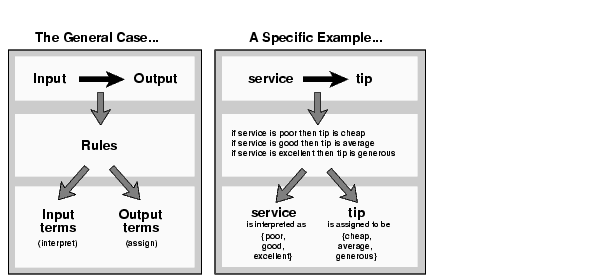

| Fuzzy Logic Toolbox |   |
Big Picture
We'll start with a little motivation for where we are headed. The point of fuzzy logic is to map an input space to an output space, and the primary mechanism for doing this is a list of if-then statements called rules. All rules are evaluated in parallel, and the order of the rules is unimportant. The rules themselves are useful because they refer to variables and the adjectives that describe those variables. Before we can build a system that interprets rules, we have to define all the terms we plan on using and the adjectives that describe them. If we want to talk about how hot the water is, we need to define the range that the water's temperature can be expected to vary as well as what we mean by the word hot. These are all things we'll be discussing in the next several sections of the manual. The diagram below is something like a roadmap for the fuzzy inference process. It shows the general description of a fuzzy system on the left and a specific fuzzy system (the tipping example from the Introduction) on the right.

To summarize the concept of fuzzy inference depicted in this figure, fuzzy inference is a method that interprets the values in the input vector and, based on some set of rules, assigns values to the output vector.
This section is designed to guide you through the fuzzy logic process step by step by providing an introduction to the theory and practice of fuzzy logic. The first three sections of this section are the most important -- they move from general to specific, first introducing underlying ideas and then discussing implementation details specific to the toolbox. These three areas are
After this there are sections that touch on a variety of topics, such as Simulink use, automatic rule generation, and demonstrations. But from the point of view of getting to know the toolbox, these first three sections are the most crucial.
 | Observations | Foundations of Fuzzy Logic |  |